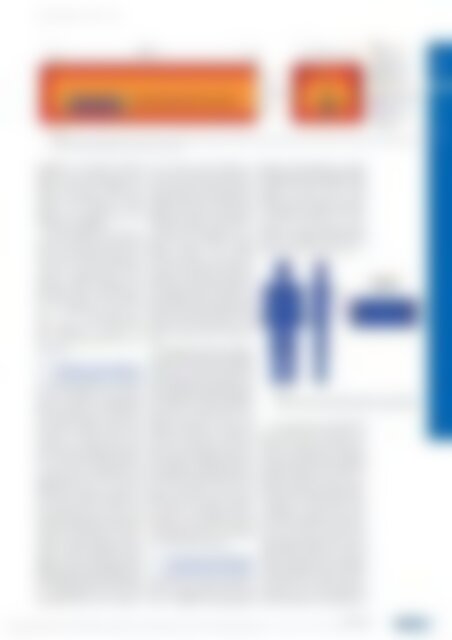Create successful ePaper yourself
Turn your PDF publications into a flip-book with our unique Google optimized e-Paper software.
<strong>atw</strong> Vol. 62 (<strong>2017</strong>) | Issue 6 ı June<br />
385<br />
| | Fig. 1.<br />
MCNP6 model of the emplacement drift with a POLLUX® cask loaded with irradiated UOX and MOX fuel. Black dots represent the position of the F5 tallies, where the letter indicates the axis<br />
direction and the number the distance in meters to the cask surface.<br />
AMNT <strong>2017</strong><br />
considered in this study, neutrons<br />
dominate the radiation field and<br />
exposure outside the shielding cask.<br />
Hence, only those isotopes that<br />
contrib ute significantly to neutron<br />
activity were considered when<br />
defining the radiation sources for<br />
simulations with MCNP6.<br />
For the considered fuel inventory<br />
the main contributor to neutron emissions<br />
is the spontaneous fission of<br />
244 Cm (90 % of the total emission) and<br />
246 Cm (5 % of the total emission),<br />
while the contribution due to (α,n)<br />
reactions, mainly stemming from<br />
interactions with 18 O, is less than 5 %.<br />
The total neutron source strength<br />
for the POLLUX-10 inventory is<br />
1.66 · 10 +9 neutrons/sec (n/s),<br />
while those for the POLLUX-3M<br />
and POLLUX-3U inven tory are<br />
9.02 · 10 +8 n/s and 3.24 · 10 +8 n/s,<br />
respectively.<br />
2.2 Calculation of the ambient<br />
dose equivalent rate Ḣ*(10)<br />
In the generic model for a repository<br />
for heat generating waste of Stahlmann<br />
et al. [2015], an emplacement<br />
drift has a length of 57 m (RSD) and<br />
63 m (CLD), respectively. The drift is<br />
surrounded by a host rock layer of at<br />
least 100 m thickness and several<br />
decimetres of concrete lining in the<br />
case of CLD. To simplify the calculations,<br />
the thickness of the drift walls,<br />
i.e. rock salt for POLLUX-10 and<br />
concrete lining for POLLUX-3M and<br />
POLLUX-3U, was set to 1 m in the<br />
MCNP6 model, which is sufficient to<br />
account for possible interactions of<br />
the radiation with the drift wall<br />
materials. With respect to interactions<br />
of neutrons and photons with clay and<br />
concrete, both materials are characterized<br />
by similar densities and elemental<br />
/ oxidic compositions, dominated<br />
by SiO 2 , CaO, Al 2 O 3 and H 2 O.<br />
Figure 1 shows the modelling of the<br />
deep geological disposal facility and<br />
the POLLUX® type cask with MCNP6.<br />
As a simplification, only one cask<br />
(cylindrical form with a length of<br />
5.5 m and an outer diameter of<br />
1.56 m) was placed on the ground of<br />
the drift with its bottom surface at<br />
2.63 m distance to the drift end side.<br />
Detailed geometrical information of<br />
POLLUX® type cask and the generic<br />
emplacement drifts can be found in<br />
[Janberg and Spilker, 1998; Filbert et<br />
al., 2011] and [Stahlmann et al.,<br />
2015], while the respective detailed<br />
MCNP6 models were already<br />
described in [Pang et al., 2016], hence<br />
they are not shown here. Since the<br />
radiation scattered by the drift layers<br />
might have an important impact on<br />
the radiation field, a third drift was<br />
also modelled. This one has the same<br />
geometry as the ones described above<br />
but the surrounding wall layers were<br />
replaced by air, representing a cask<br />
free in air (from now on in short as<br />
FIA).<br />
As denoted by black dots in Fig. 1,<br />
twelve MCNP6 point detector F5 tallies<br />
[Pelowitz et al., 2013] were employed<br />
to calculate the neutron fluence rate<br />
and the ambient dose equivalent rate<br />
Ḣ*(10) at different positions inside the<br />
drift. Tallies X1, Y1 and Z1 (see Fig. 1)<br />
were defined to compare Ḣ*(10) at 1 m<br />
distance to the cask surface in the<br />
respective directions. To study the<br />
change of Ḣ*(10) with the distance to<br />
the cask, the tallies X1 to X10 (see<br />
Fig. 1) were also employed. The neutron<br />
fluence- to-ambient-dose-equivalent<br />
conversion coefficients given by<br />
ICRP [1996] were employed to convert<br />
the F5 tally results into Ḣ*(10). To<br />
assess the precision of the result,<br />
MCNP6 produces a wealth of information<br />
about a simulation, which is<br />
represented by ten statistical checks<br />
[see Pelowitz et al. (2013)]. To pass the<br />
ten statistical checks, 2 · 10 +7 particles<br />
were required per simulation.<br />
2.3 Calculation of the personal<br />
dose equivalent rate Ḣ p (d)<br />
To obtain the personal dose equivalent<br />
rate Ḣ p (d), a worker inside the<br />
drift was represented in this study<br />
with a simplified anthropomorphic<br />
phantom. This phantom is a virtual<br />
representation of the BOMAB (BOttle<br />
MAnnikin ABsorber) phantom, which<br />
models the head, neck, chest,<br />
abdomen, thighs, calves, and arms<br />
with cylinders or elliptical cylinders.<br />
A detailed description of its components<br />
can be found in [U.S.<br />
Department of Energy, 2016]. Figure 2<br />
shows the MCNP6 model of the<br />
phantom used in the current study.<br />
| | Fig. 2.<br />
MCNP6 representation of the BOMAB phantom with a cylindrical detector<br />
at the front side (chest dosimeter) and at the back side (back dosimeter).<br />
As recommended by ICRP, [2007]<br />
the personal dose equivalent rate<br />
Ḣ p (d) at a depth d=10 mm gives a<br />
conservative assessment of the effective<br />
dose rate under most irradiation<br />
conditions. However, this requires the<br />
personal dosimeter to be worn at a<br />
position on the body which is representative<br />
with respect to the exposure.<br />
In general it is recommended to wear<br />
a dosimeter in front of the chest,<br />
where Ḣ p (d) is supposed to give a conservative<br />
estimation of the effective<br />
dose even in cases of lateral or isotropic<br />
radiation incidence on the body<br />
[ICRP, 2007]. However, in cases of<br />
exposure from the back, the question<br />
arises if a dosimeter worn at the front<br />
still appropriately assesses the effective<br />
dose. For a worker inside an<br />
emplacement drift, as investigated in<br />
the current study, a certain amount of<br />
AMNT <strong>2017</strong><br />
Monte-Carlo Based Comparison of the Personal Dose for Emplacement Scenarios of Spent Nuclear Fuel Casks in Generic Deep Geological Repositories ı Héctor Saurí Suárez, Bo Pang, Frank Becker and Volker Metz

















